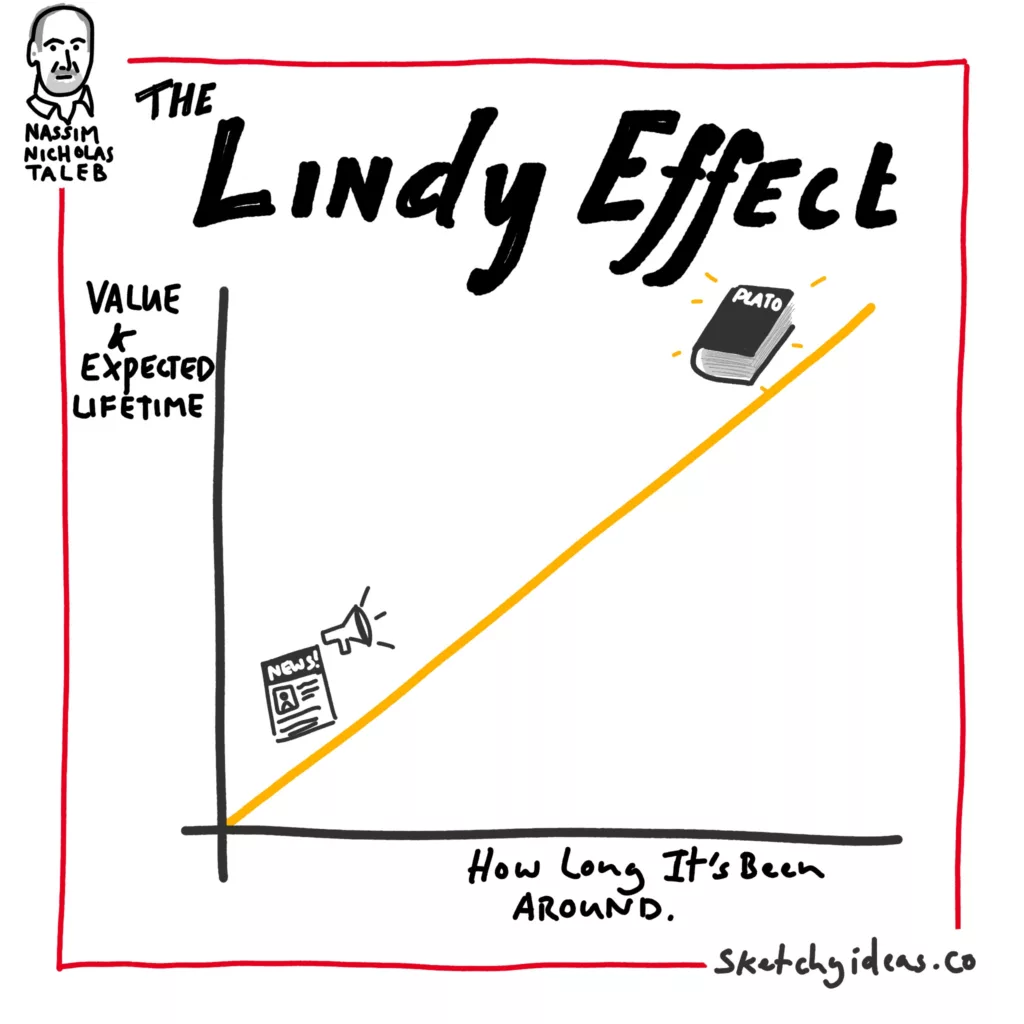Will this matter in 10 years time?
It’s a difficult question to answer, but being able to make such a prediction is incredibly valuable. One principle that can help is the Lindy Effect, a simple mental model that can help predict the longevity (and probable value) of any non-perishable good.
So buckle up as we take a quick tour of what it is, where it comes from, the limits of the idea and how you can apply it.
What is the Lindy Effect?

The Lindy Effect is a mental model to predict the value and life expectancy of ideas, concepts, technologies and even businesses. It’s based on the principle that the longer something has endured, the greater the value it has and more likely it is to continue to endure.
For example, the works of Plato still sell well and are influential on Western thought. You can safely predict
- they will still sell well in 10 or even 50 years
- A recently published philosophy book is unlikely to sell as much in 10 years
- One of Plato’s books would be more valuable for you to read.
Where does the Lindy Effect come from?
Nassim Nicholas Taleb first coined “The Lindy Effect” in his book Antifragile. He stated that you could use the length of time a book has been in print to predict how much longer it will be in print. Rather than ageing out of value, they seem to age in reverse.
The name comes from the association with Lindy’s Deli on Broadway. Albert Goodman first noted “Lindy Law” where he observed comedians at the Deli. He noted that those who took on smaller workloads at the start had longer careers than those who burnt out.
Eventually, Lindy’s Deli became an example of the effect. It operated from 1921 – 1969 and again from 1979 – 2018 while other restaurants around it shut.
Why Does the Lindy Effect Matter?
The Lindy Effect provides a simple tool to calculate both how long an idea will last and how valuable it is.
For many of us “new” means “better” even though it’s not true. But the ideas and principles which have withstood the test of time are far more likely to be good.
This is similar to the idea from Jeff Bezos that it is easier to predict what will stay the same rather than what will change.
It doesn’t mean that the exact appearance is the same, but the principles behind them are the same. For example, the desire to be entertained is as old as time but the way we get that entertainment has changed a lot (streaming services, TV, cinema, theatre, stories around a fire).
The limits of the Lindy Effect
While the Lindy effect is a good heuristic, it has its limits.
The music charts show that a number one single can and will drop off the top charts even if it has been at number one for many weeks. Likewise, Although Lindy’s Deli was in operation for a long time, it eventually closed in 2018.
Similarly, legacy industries and giants are suspectable to upstarts who come along and approach old problems in fresh ways.
However, these examples also show the value of the Lindy Effect.
With the music chart, it’s more likely that the song from the 70s which is still popular will remain in the top 40 than the new single that shoots to number one.
And although new upstart companies do replace legacy businesses and industries, they do so by solving the underlying desires in new way. While the solutions change, the principles remain.
How to Apply the Lindy Effect:
There are two clear lessons from the Lindy Effect.
Prefer the timeless and tested to the new and novel
When it comes to ideas, books, music or whatever, you’ll probably get more value from a classic.
There’s certainly value in new ideas and experiences but they are less likely to last. If they demonstrate timeless, underlying value or principles then they are more likely to be valuable in the long run.
Predicting longevity with the Lindy Effect
If you want to predict how much longer something will last, double how long it’s been around for.
This only works with non-perishable things (DON’T use this for calculating how long the milk will last or how long someone will live), and works well as a general rule of thumb.
There are always exceptions but when you compare two options, using the Lindy Effect is a better guide than most other tools.
Making ideas that last
The Lindy Effect is a great heuristic to simplify a nearly impossible process.
While it has its limits, it provides a simple guide and reminds us of the value of resilience over the novel.

Leave a Reply